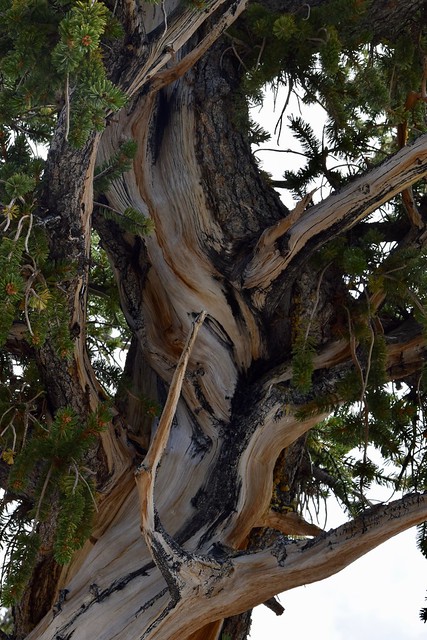
The bristlecone pine’s struggle to survive in a harsh environment creates a living sculpture. Its beauty is a physical manifestation of what happens to thought when it’s transformed through concentration into poetry, according to poet Jane Hirshfield.
Difficulty, said the poet Jane Hirshfield, needn’t hinder the artist, but can be a path toward concentration, that particular state of mind “penetrating and unified, yet also permeable and open,” that place where both art and answers to perplexing problems reside.
Hirshfield’s essay in her 1998 collection, “Nine Gates: Entering the Mind of Poetry,” is an exquisite examination of concentration.
“Just as geological pressure transforms ocean sediment to limestone, the pressure of an artist’s concentration goes into the making of any fully realized work,” Hirshfield wrote. “Much of beauty, both in art and in life, is a balancing of the lines of forward-flowing desire with those of resistance–a gnarled tree, the flow of a statue’s draped cloth.”
Her words remind me of the contorted and burnished limbs of bristlecone pine, ancient trees that live in the moonscaped White Mountains on Nevada’s eastern edge. Bristlecone pines grow in rocky and alkaline soil, a type of limestone called dolomite that was formed when the area was a warm, shallow, prehistoric sea, a soil inhospitable to almost all other trees.
“Great art, we might say, is thought that has been concentrated in just this way: honed and shaped by a silky attention brought to bear on the recalcitrant matter of earth and life,” Hirshfield said. “Through such tensions, physical or mental, the world in which we exist becomes itself.”
If writing is revelation, the poet said, then narrative becomes a discovery of not only beauty but also of truth. The writer is “learning how to attend unswervingly, moment by moment, to themselves and their art; learning to come into steady presence, free from the distractions of interest or boredom,” she said.
There’s comfort and guidance in Hirshfield’s words, and in the connection between writer and tree, a link that extends beyond one serving as a source of paper and pencil for the other: the tree itself is a recorder of its difficult world.
With steadfastness and sensitivity, the bristlecone pine responds to changes in rain and snowfall. The striations of dark and light wood are a written history of the Earth’s climate, stretching back continuously for almost 10,000 years, according to the U.S. Forest Service. The tree’s uninterrupted record of time allowed scientists to recalibrate the radiocarbon dating method and rewrite human history.
A grove of bristlecone pine is akin to a great cathedral, a place sacred and wise. The hikers I met on the path were quiet.
“Through poetry’s concentration great sweeps of thought, emotion, and perception are compressed to forms the mind is able to hold–into images, sentences, and stories that serve as entrance tokens to large and often slippery realms of being,” Hirshfield wrote. “Shaped language is strangely immortal, living in a meadowy freshness outside of time.”
Here I must leave Hirshfield and her meadow for the weathered beauty of the immortal poet-pine living in the cold, dry mountains of my lifetime.
Leave a Reply